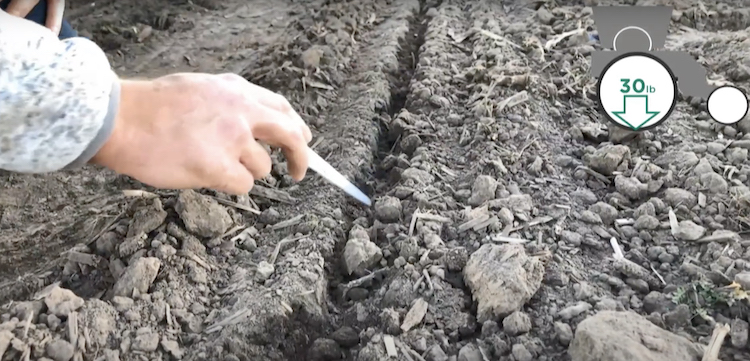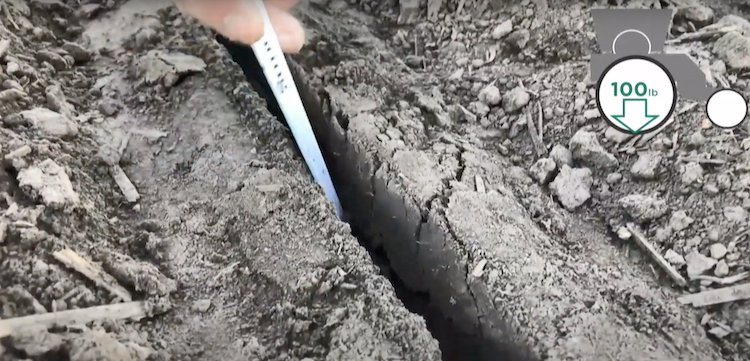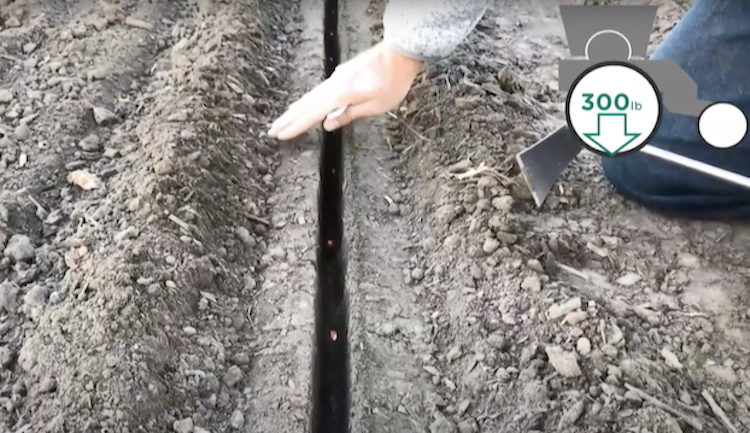Down force has become a hot topic over the last 10 years in precision agriculture. Does it really matter? How can knowledge of your down force help you?
The goal of a good seed furrow is to have a clean, open, and consistent environment for every seed. What you want is equal moisture, equal temperature, and good consistent soil density for every seed. By doing this you achieve the uniform germination and emergence that you’re striving for. In the end, this creates optimal yield potential.
The photo above shows an example of a down force setting that’s too heavy for the conditions. The first thing you’ll notice is that on the surface of the ground there’s a very pronounced gauge wheel footprint that you can visually see. That’s your first indication that the gauge wheels are carrying quite a bit of weight. The average gauge wheel weight for the pass shown here was 300 pounds on the gauge wheels.
Next, look inside the furrow. The good thing about carrying this amount of weight is you’re achieving a very clean open seed furrow environment. You’re going to have a good consistent environment for each seed in that furrow. The problem with carrying this much weight is that when you dig and pick along the sides of the seed furrow, you’ll feel how dense and compact that soil is. Carrying 300 pounds of gauge wheel weight is a lot of weight for many soil environments. There’s quite a bit of compaction and this is going to be a problem with your closing system and its ability to put this soil back together and have a good environment for seeds to grow in and will impact root development later in the growing season.

TOO LIGHT. When down force pressure is too light, the furrow environment is too loose and the sidewall integrity is lost.
The second example is of a down force setting that is too light for the planting conditions. Here the furrow is ¾ of the way shut already. Even with no closing systems engaged the furrow collapsed in on itself. Down pressure was only about 30 pounds of weight carried on the gauge wheels, which left the furrow environment too loose. The integrity of the sidewalls was lost, and they caved in. What caves in around that seed is dry soil and clods. This creates an inconsistent environment for germination and emergence. You’re not going to achieve the uniform moisture and temperature that you’re wanting, and you won’t get the optimum stand because of this. When you dig around in that soil you can just feel how loose it is. That’s just another way to tell. The gauge wheel imprint is not there. When your gauge wheels are too light, you’ll struggle to find their imprint on the surface of the ground.

JUST RIGHT. When your down force is just right, you'll achieve a good, clean, open furrow environment that will have consistent moisture, temperature and soil density.
In this last example, the down force setting was just right for the conditions. There is about 100 pounds on the gauge wheels. This happens to be about the optimum range to be in for this type of planting environment. You’re achieving that good, clean, open furrow environment. Here you can achieve consistency from seed to seed when it comes to moisture, temperature, and soil density. You can see the gauge wheel imprint, which you want to see a little bit of, just not too much. Seeing the gauge wheel imprint is a good thing, meaning that you’re carrying a little bit of weight on the gauge wheel tires. When you dig alongside this furrow your digging tool easily pokes into the ground. You can see some movement of the soil as you poke at it.
Looking inside the furrow and doing a little bit of lifting you’ll see it crumble and fall apart. This is a good sign. You can have confidence if this is the open furrow environment you’re seeing that your closing system is going to be able to do a good job of closing the furrow. You’ll achieve good density around the seed, have good emergence, and good root development later.
Remember as you’re setting your down force system you want to think about choosing the optimum gauge wheel weight for the planting conditions that you’re in. You want to achieve good furrow structural integrity. This means a clean, open, and consistent seed environment in your planting conditions. You should use your down force setting as a tool. If planting conditions get drier it’s going to be harder to hold that sidewall, so you’ll probably need to have more weight on the gauge wheels. That’s ok because compaction is not a risk in drier conditions. When you get into wetter planting conditions you probably need to choose a lower gauge wheel weight, because now compaction is a high-risk problem. It’s going to be easy to hold an open furrow sidewall in a wetter condition.
Now you know you can use your down force setting to help control your furrow’s structural integrity. Use it to make sure you get an optimum seed furrow environment for the best germination and emergence uniformity in the planting conditions that you have.
A Premier Precision Planting Dealer is your partner to help you achieve a picket fence stand this spring and steer clear of the regret that comes from avoidable yield loss caused by lack of maintenance. Find your local Precision Planting Premier Dealer at planterexpert.com.
To watch videos of all recommended annual maintenance checks, visit PrecisionPlanting.com/Maintenance.
Download the free Planter Maintenance Guide. This guide includes a 1-sheet checklist, links directing you to the corresponding videos, and an overview of 15 key maintenance areas on your planter.
The Planter Maintenance series is brought to you by Precision Planting.
For farmers who believe in better. Believing in better is a mindset to pursue excellence in everything you do. It’s welcoming opportunities to improve your farm and knowing that your best season is simply a starting point for this season. Precision Planting is for farmers like you who Believe in Better.








Post a comment
Report Abusive Comment